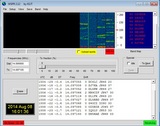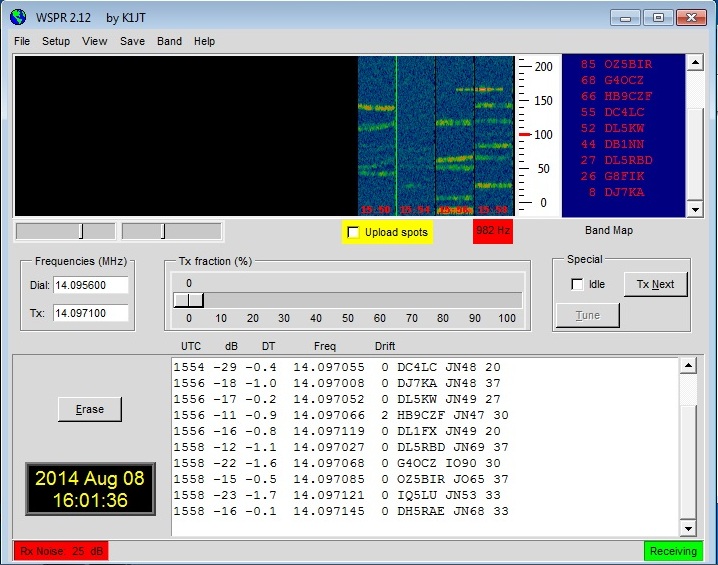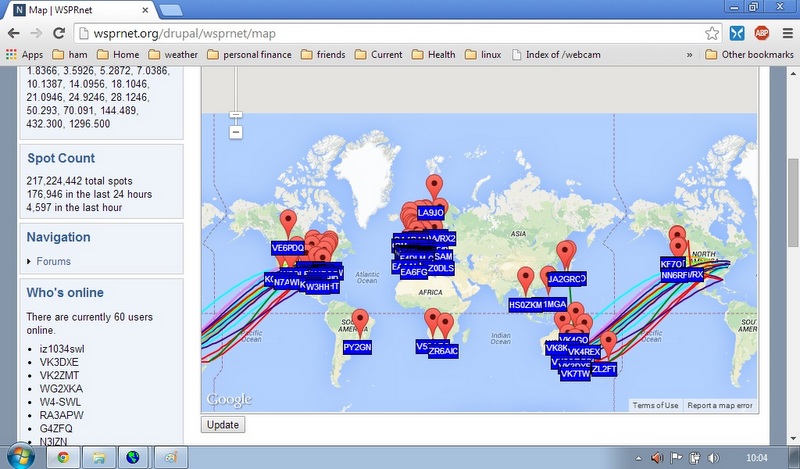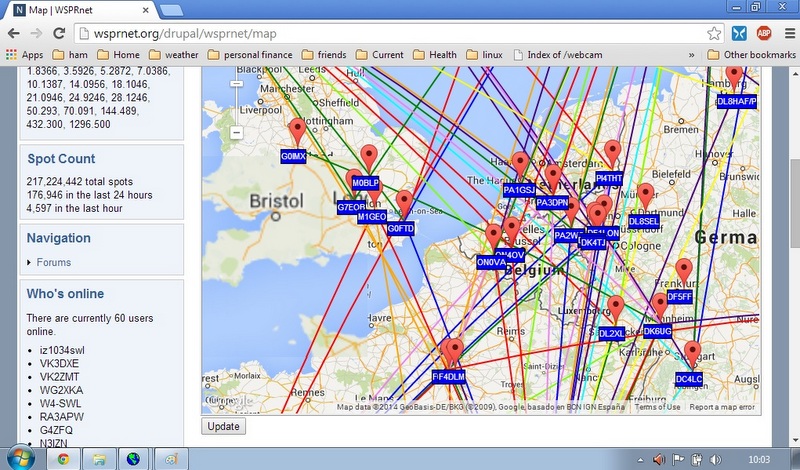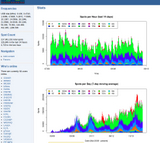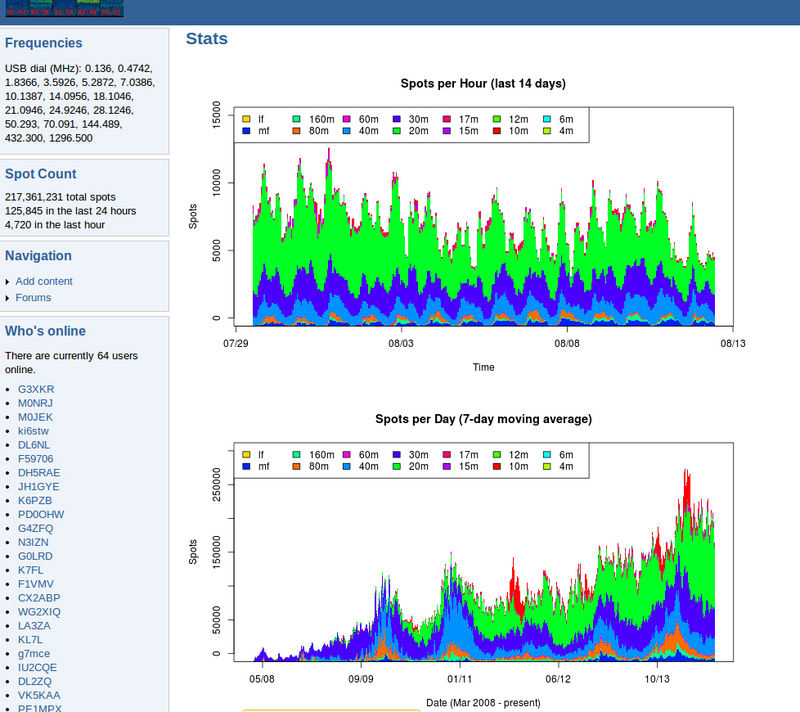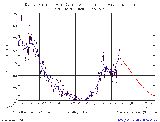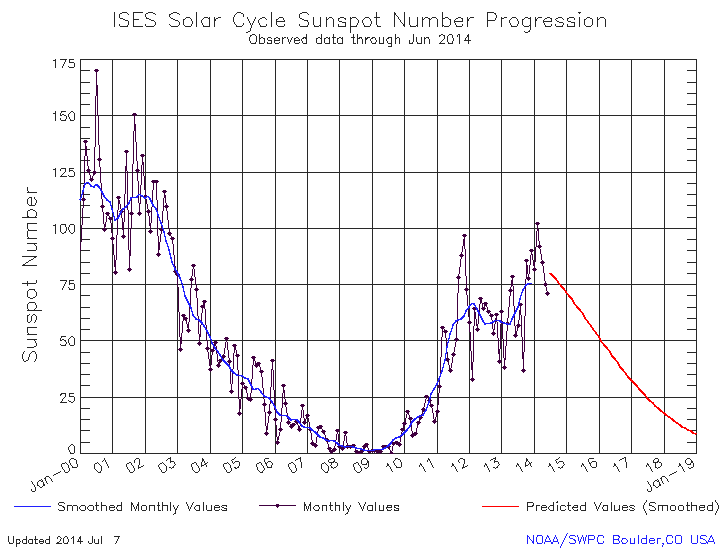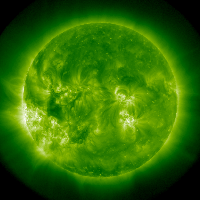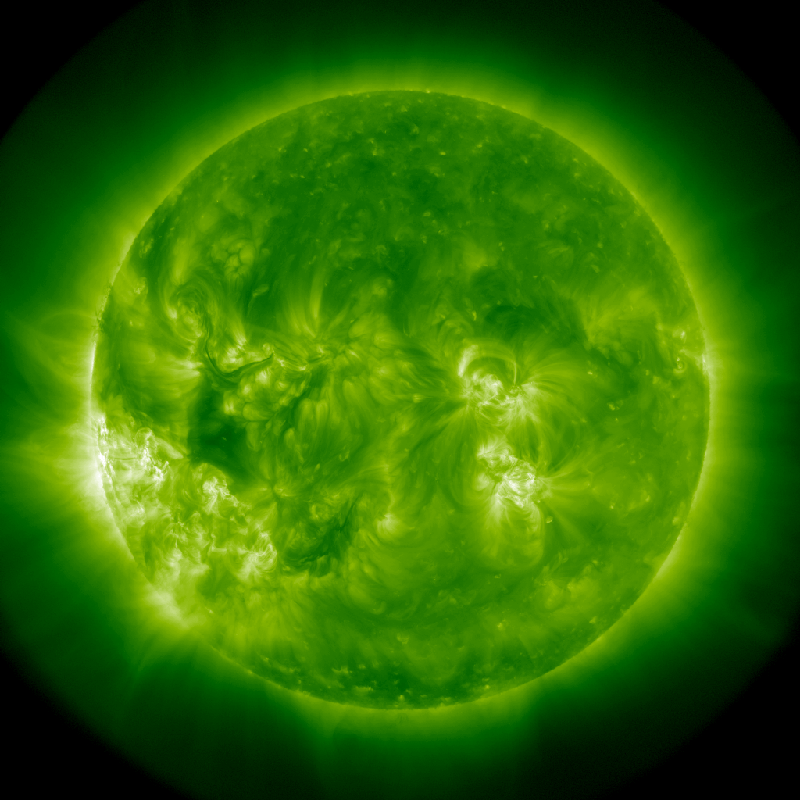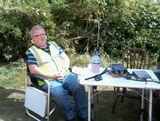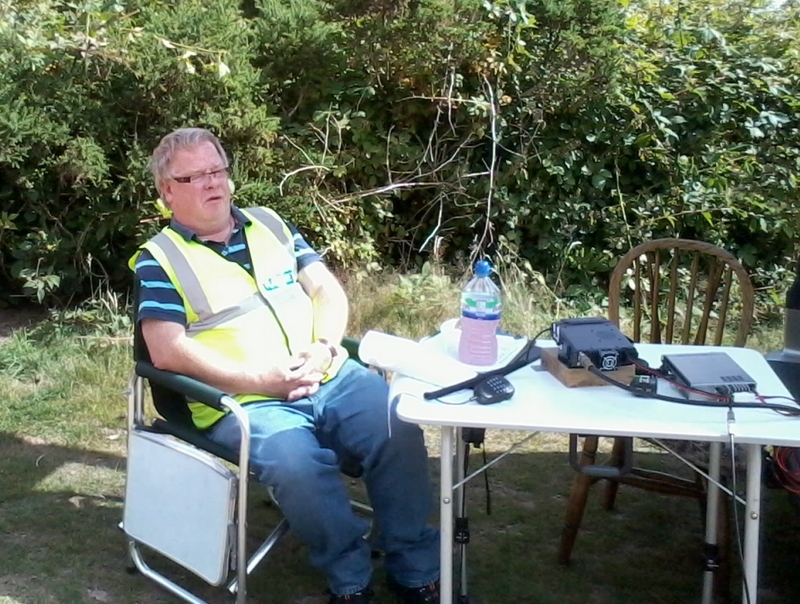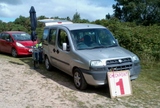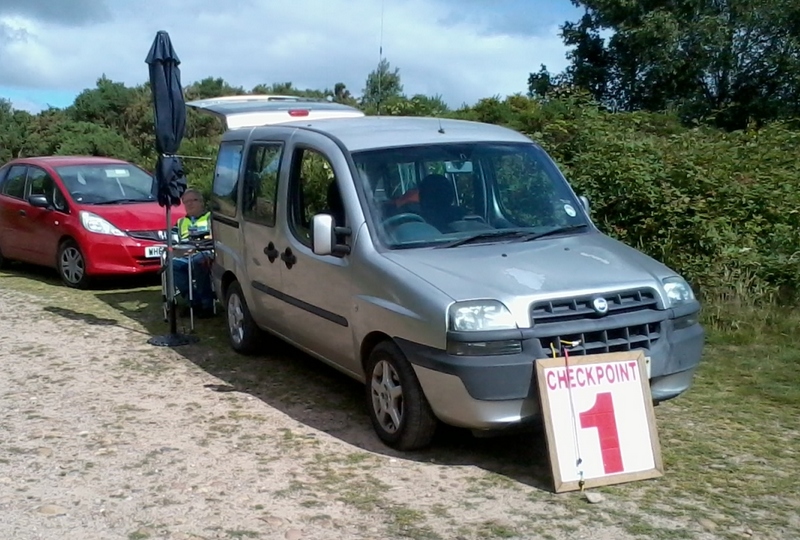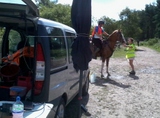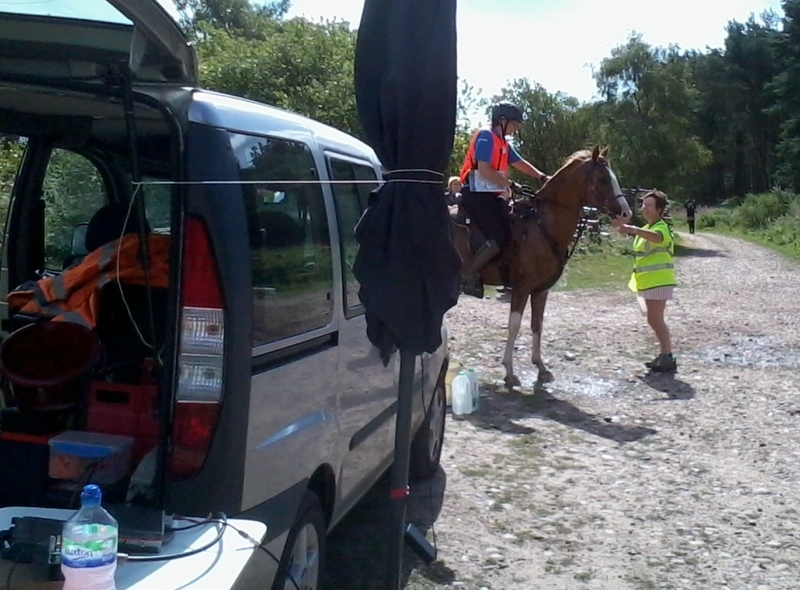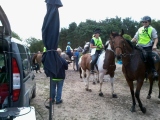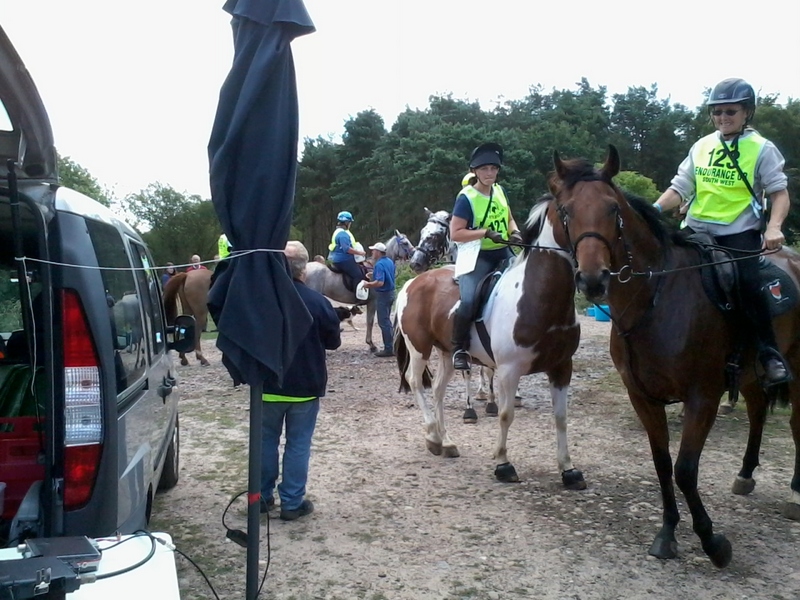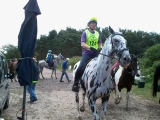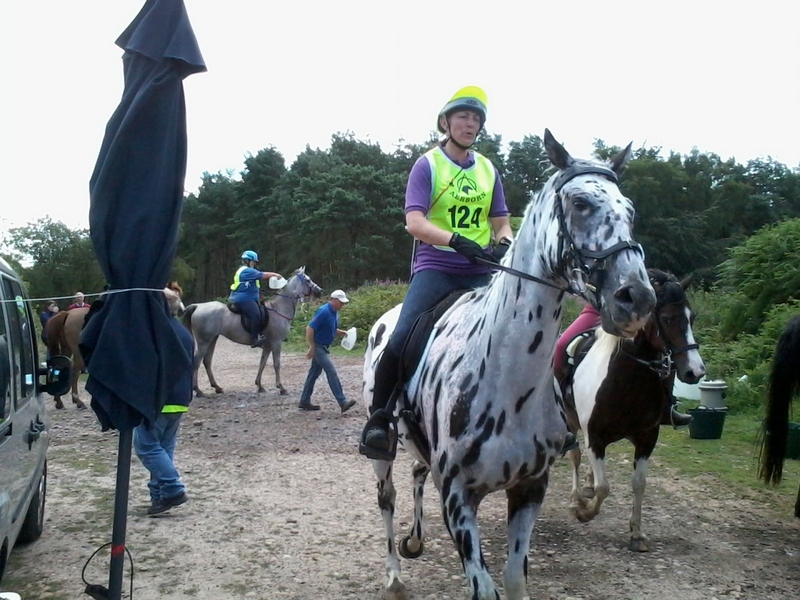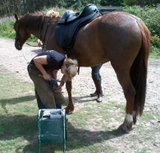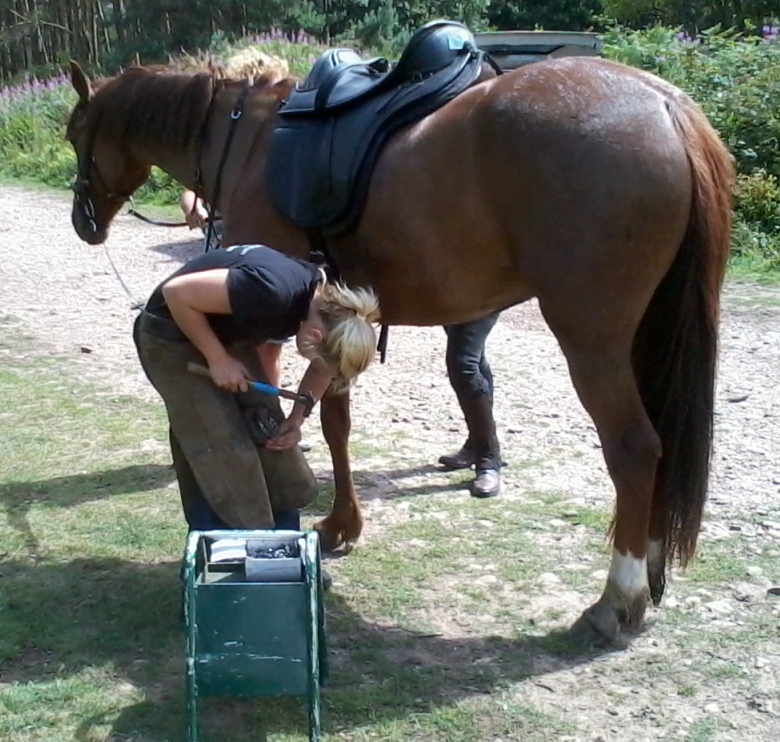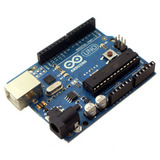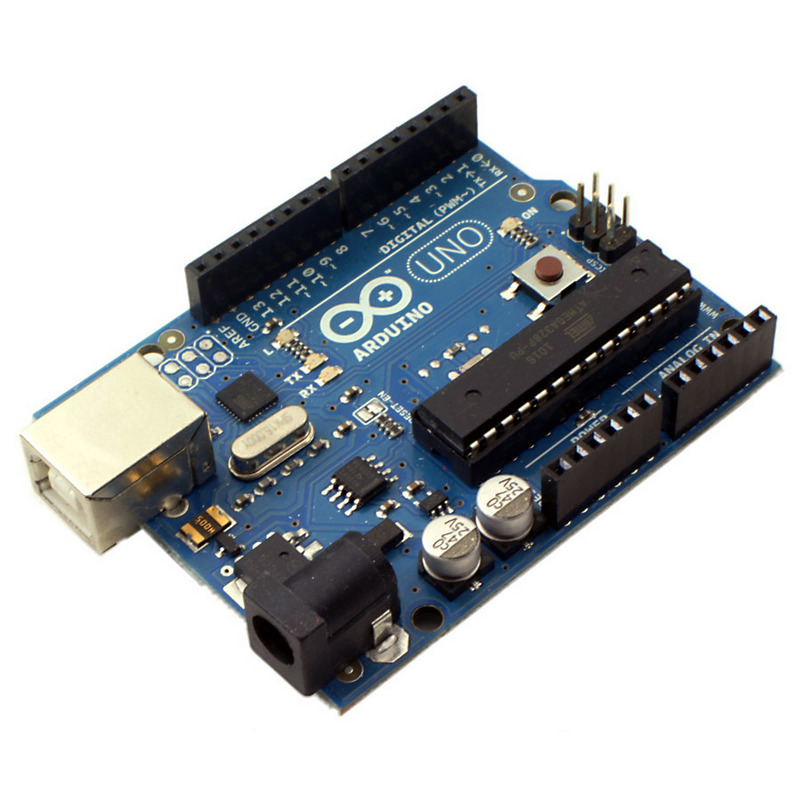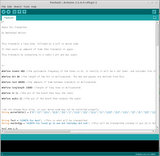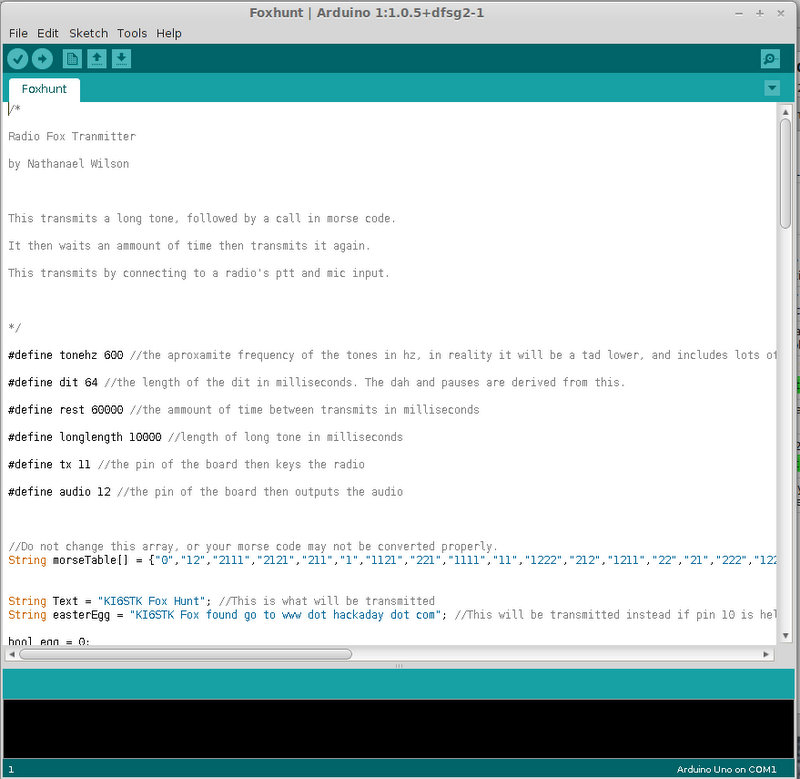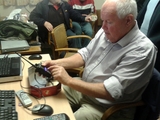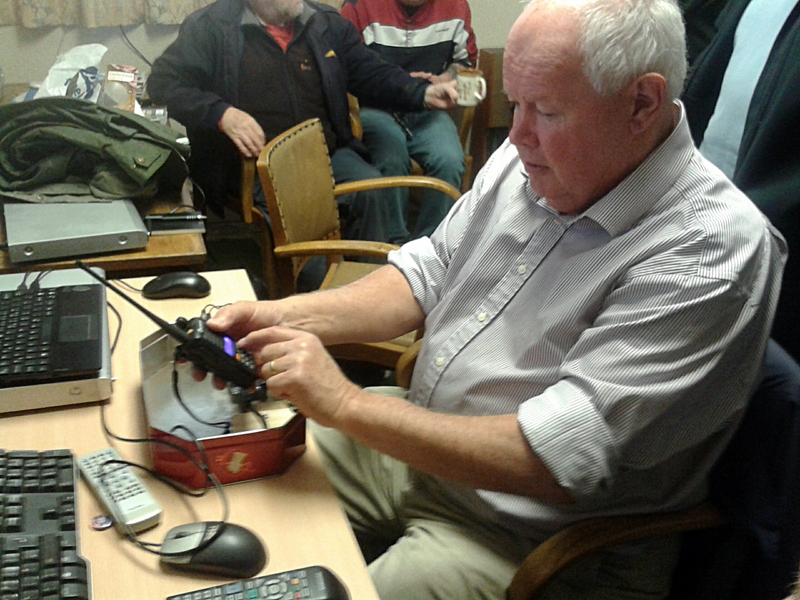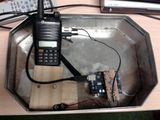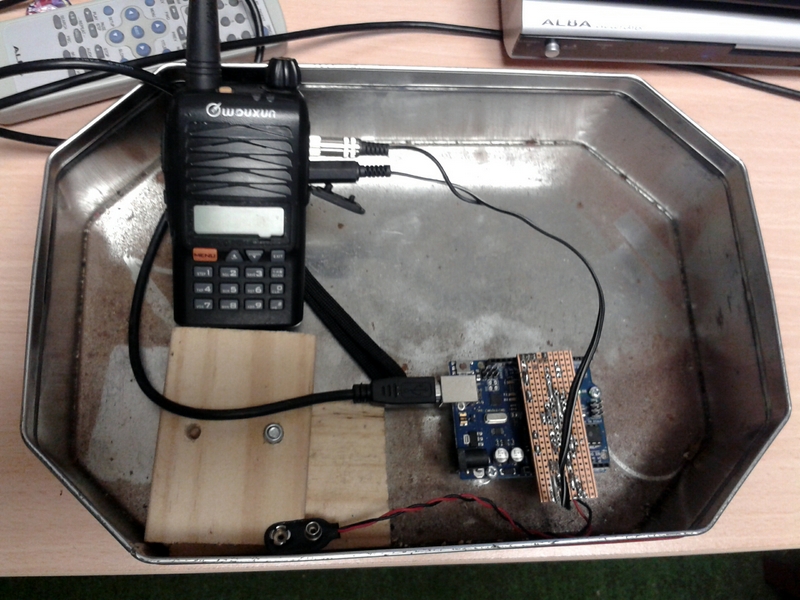
Our club on Youtube
Nets
Raynet
Repeaters
Training
Members only
Devon Shipping Live Map
Devon Air Traffic Live Map
Links
About us
2014 EARS Club meetings
| 22 December 2014 Vintage, valves and steam night in the Moose Centre at 7 p.m. Pete G3ZVI brought in a home-built crystal radio receiver that fascinates his grandchildren because they cannot find the battery or the on/off switch! He also showed a 3 watt 10 GHz reflex klystron. The Varian VA-242U was possibly used in industrial instrumentation or in a distance-measuring system. |
10 December 2014 The annual EARS Skittles Night was held in Moose Centre. Pictures of the eating and skittles action show the usual titanic struggle between the top bowling-pin bashers in the West!
| 24 November 2014 It was "Bring In Something Interesting Night" at the club and members responded with items that were old, new, obscure, original and fascinating. John G4AP brought along an antenna tuning unit that was part of the T1154 transmitter used in WWII bombers. |
||
Alan G1JXI brought a collection of Baofeng accessories that members could look at to see if they worth buying, should they want to expand their use of the devices. A mystery antenna was analyzed by Andrey KG6HGF, Michal M0HRJ and John G8XQQ, but no one could decipher its use. |
||
Skip 2E0TGT constructed a 2m "beer-can dipole", which members scrutinized to see if a better impedance match could be obtained. Skip plans to make a 10m one from metal dustbins next! He also wants to empty many full cans of different drinks to assess the effect of beverage on gain. Alan G1JXI unwrapped a vintage home-built drum kit constructed from neoprene over piezoelectric transducers coupled to a drum machine. |
||
| Not to be outdone, Skip whipped out his home-built bass guitar and explained his plans for winding his own coils. These kind of projects are ideal for demonstrating working electronics on our Open Day next summer. |
| 10 November 2014 The evening began with a Society Extraordinary General Meeting to unanimously elect Linden "Skip" Allen 2E0TGT to the post of EARS Secretary. As mentioned in the previous meeting's entry below, Geoff M0UWD has retired as Secretary after many years of service. The dedication and diligence he brought to the post will be long remembered, not to mention his superb skills as a project builder. |
||
| Club members then gathered around many cardboard boxes full of tools, components, equipment and spares to decide what could be recycled safely and what was worth keeping. Following that, Ivor G6ATJ put on one of his famous Video Evenings, featuring amateur radio videos. Most popular was the Hancock Half Hour episode entitled "The Radio Ham" that many of us had not seen before. |
27 October 2014 Tonight's club meeting saw Alan G1JXI show his Bluetooth adaptor for controlling a Yaesu radio using it's CAT interface (accessory socket). Using a tablet computer running Pocket RxTx, users have complete control over the radio operation from the comfort of their armchair, avoiding squinting at the tiny display of an FT-817.
Pete G3ZVI announced that his 4 metre Parrot repeater was en route to his QTH for testing for Raynet use. He also drew members attention to a software update from FTDI that uses Windows Update to brick cloned FTDI RS-232 interface chips. Although FTDI have withdrawn the update, users worldwide were amazed at how their serial interface applications suddenly stopped working.
Members also short listed EARS club meeting topics for 2015.
22 October 2014 Congratulations to Andrey KG6HGF and Matt M6ULP on passing their Intermediate Licence exams tonight!
| 13 October 2014 Pete G3ZVI gave a wide-ranging talk about the GB3EX repeater at Silverton that came on air a few months ago. He explained the design process, technical trade-offs, power limitations, remote control management and the hunt for suitable low cost hardware. Pete drew a block diagram showing how new devices were added to enable the repeater to to operate not only as a crossband repeater but an in-band Raynet repeater. |
||
| He explained the difference between a diplexer and a duplexer and dismantled a typical repeater duplexer so members could see the construction of the tuning assemblies. | ||
| John G8XQQ brought along his latest portable 2m and 43 cm mobile rig with its DTMF keypad and demonstrated how the repeater was remotely controlled and polled for service status. Allan G1JXI brought along a DSTAR HotSpot built from using a Raspberry Pi and a Digital Voice Access Point dongle. This was just to tempt club members into wanting to learn much more about this interesting aspect of the hobby. |
22 September 2014 The club met for a Social Evening.
8 September 2014 The Club met to technically review the Exeter Raynet participation in the recent Marie Curie Cancer Care Devon Ten walk at Killerton. Also Andrey KG6HGF worked on completing his practical assessment for his Foundation Licence using the club's HF communication system.
| 30 August 2014 The GB3EX repeater near Silverton, north of Exeter, is now complete, with following the installation of a wind generator by club members Pete G3ZVI, Keith G7NBU, Skip 2E0TGT and Alan G1JXI. The site now has primary and secondary power supplies provided by solar and wind energy. |
| 23 August 2014 Exeter Raynet provided communications for the Marie Curie Cancer Care Devon Ten fundraising walk at Killerton Estate. Perfect weather for a late August evening meant that the 260 walkers had a rewarding and exhilarating 10 km walk around the estate, culminating with a concert and fireworks. |
||
|
In the Exeter Raynet Hub caravan, John G8XQQ coordinated links with 6 Raynet members posted at marshal points. John enjoys a brief rest from the radios as Pete G3ZVI joins him in the Hub. On the right, Ivor G6ATJ and Keith G7NBU relax after returning from their marshal points. Using the new GB3EX UHF repeater operating on Raynet frequencies for the evening, seven mobile sites stayed in touch with the event organiser to provide progress and message information. |
||
|
Meanwhile, walkers returned before it got too dark, then headed for the refreshment stand and music stage, but not before capturing the moment for posterity. Quote of the evening was overheard at the half-way water station, where a thirsty walker saw the high-vis jacket and handy on the Raynet member, and declared "Security's here! This place must be selling the hard stuff"." |
| 11 August 2014 Nick M0NRJ hosted a tutorial on WSPR and how this low power all-band Weak Signal Reporting Network information can be used by radio amateurs to learn about propagation and band openings. He began by installing the latest control program from the WSPR, then entering the basic parameters. It is a network of beacon transmitters each transmitting a very slow 1.6 bps stream of data that encodes the transmitter callsign, locator and power level, which takes 110 seconds to transmit. This repeats every 20 minutes. |
||
|
WSPR receiver sites receive and decode the messages and periodically upload them to the WSPRnet where they are collated and displayed. Maps show more detail as the user zooms in on a particular area, having selected a frequency band to inspect. PCs need an accurate network time synchronization program such as Dimension to ensure accuracy of tuning into the signals at the moment they start, just after every even minute. |
| 28 July 2014 The club evening began with Andrey KG6HGF performing his practical assessment for his Foundation Licence. In the syllabus this is Section 8E on "competence in making radio contacts". Here he is seen doing a supervised VHF contact on a handy. Then he moved to the HF radio to tune into SSB QSOs on 80 metres, after he had done Section 8F on "connecting a transmitter/receiver". |
||
|
Matt M6ULP then did one of the assessment topics for the Intermediate Licence. Tonight, with the assistance of an oscillator supplied by Geoff M0UWD, he did Section 10F which is a "simple frequency calibration". John G8XQQ carefully monitored the variation of the frequencies being generated using the club's digital frequency counter. |
||
|
The state of sunspot activity was discussed tonight as Nick M0NRJ presented the latest news on whether "Solar Max" has passed. Using data from NASA's Solar Dynamics Observatory, he showed information announcing that the sun's magnetic poles had recently reversed, signifying that a new solar cycle has started. He also drew attention to the many web sites carrying live information such as Space Weather and explained that on the downward slope of the activity curve, Earth was more likely to experience a solar super storm such as the one in 2012 that just missed the earth. |
14 July 2014 Club members held a lengthy review of their services provided to the 2014 Clinton Estates Endurance Ride for horses from Bicton Arena around Woodbury Common on the previous day. As well as providing core communications on 70 cms between the main arena and five check points, members became time recorders and support personnel to the riders and event visitors.
Welcome to new member Andrey KG6HGF from the USA who joined the club this evening and is ready to commence his Foundation Licence examination.
| 13 July 2014 Exeter Raynet members provided communications, timekeeping and logistic support to the Clinton Estates Endurance Ride on Woodbury Common for the day. Ivor G6ATJ grabs a well-earned rest before the next set of horses arrive for watering, feeding and cooling down at Checkpoint 1. |
||
|
These pictures captured by Phil 2E0PCJ capture the action as horses arrived at his checkpoint. They cantered around a hilly 80 km course with Raynet members at 5 checkpoints providing constant updates on the location of every horse and rider. |
||
|
Raynet members logged the arrival of over 120 horses and riders and radioed the information back to Keith G7NBU and John G8XQQ who manned the Control Hub in Bicton Arena. |
| 7 July 2014 The annual and now legendary EARS Club BBQ was held at Keith G7NBU's QTH. Click on the picture to see more photos, including "Biggles Ivor G6ATJ" and his quadcopter demonstration flight. |
| 26 June 2014 Alan G4TKV has won the 2014 EARS Club Constructor Challenge! Congratulations to Alan, especially as he did it remotely from his Cornwall QTH. Alan has been educating himself on higher frequencies for a while. He has now made some progress and received the St Austell 23cm beacon. |
||
|
On the left is his project to generate a stable 96 MHz signal. The issues are frequency certainty and and stability because it is multiplied so much. The design used direct synthesis, so using a bag of 48 MHz crystals from Ebay (which is much cheaper than using 96 MHz crystals), he began development. 96 MHz is the magic number as this gets multiplied to 1152 MHz so a 2m rig can be used as an IF (1152 + 144 = 23 cms) On the right is 96 MHz crystal oscillator. |
||
|
On the left is a broadband preamp designed for 384 MHz giving 40 dB gain and about 25 dbm output. This will be used to drive the converter LO better. The 384 MHz is tripled to 1152 MHz (for a 2m IF). The converter needs a lot of drive power for the diode multiplier. On the right is his brass interdigital converter. |
||
|
To communicate with the St. Austell beacon, Alan made a 23cms yagi. Using aluminum from a local household supplier, the hardest part was getting the half-wave phasing line (balun) to be the right length. |
23 June 2014 Club members had a Natter Night and provided guidance to Matt M6ULP, who is preparing for his Intermediate Level practical assessment.
| 9 June 2014 A workshop on programming portable handies such as Wouxun, Baofeng, TYT and Puxing was hosted by Pete G3ZVI and Nick M0NRJ. Keith G7NBU's Baofeng was not working with its supplied PC program that set the channel names and frequencies. By locating the correct USB driver and using the CHIRP control program, Keith was able to access the handy memories. |
||
| Club members watched the attempts to diagnose programs such as incorrect versions of control programs, missing drivers or incorrectly wired connection leads. The CHIRP program's broad variety of supported radio interfaces makes it indispensable. Matt M6ULP started on his Intermediate licence practical exam under the close supervision of John G8XQQ. |
The third episode of the TX Factor Show is now live! As well as stories on kite flying HF antennae and the Military Wireless Museum, it features the Exeter Amateur Radio and Electronics Rally with Pete G3ZVI giving a rare interview.
| 12 May 2014 Nick M0NRJ gave a demonstration of the Arduino Uno and how it can be used for simple amateur radio projects like a fox hunt hidden base station. He showed how the Arduino Integrated Development Environment (IDE) is used to write a program,compile it and download it to the Arduino Uno. |
||
| He chose the Fox Hunt transmitter published by Nathanael Wilson and explained how he designed an interface circuit for it to control a Wouxun VHF portable. Assembled into a biscuit tin, the transmitter could be hidden for a couple hours, whilst it sent out regular CW callsigns and tone sequences every five minutes. |
3 May 2014 Stories and pictures about the construction of the new UHF repeater GB3EX has been added to the Repeaters page.
| 28 April 2014 John G8XQQ brought in his sophisticated Marconi radio communications test equipment so that members could check their radio equipment for power levels, frequency calibration, CTCSS tones and more. |
||
| Pete G3ZVI brought in some wonderful examples of his early home-brew test equipment that he built over the last 50 years. He showed how his grid dip oscillator (GDO) was used to measure the resonant frequency of circuits as they absorbed power from the meter. |
14 April 2014 Keith G7NBU led a discussion reviewing recent Southwest Raynet exercises and discussed the club's participation in Field Days this summer. The Practical Wireless 144 MHz QRP contest on 15 June was selected as the most suitable event. Skip 2E0TGT and Bas G0FGE showed the results from last year placing them at 72nd in the contest, and they hope we can do better this year!
Geoff M0UWD brought in a digital TV so Nick M0NRJ was able to connect up a Raspberry PI and give a demonstration of how it can be used to learn to program computers with the Scratch language.
24 March 2014 Nick M0NRJ installed and configured an RTL-SDR dongle on a laptop computer running SDR# on Microsoft Windows 7. He explained that the dongle driver software is separate from the software defined radio program that visualizes the tuning spectrum and decodes the audio. For less than £8, a typical DVB-T dongle is fantastic value for learning about software defined radio. There are, however, bandwidth limitations on many digital television dongles that rule them out of direct use on HF. Upconverters sell for £35 that allow them to be used on HF bands.
There are many alternatives to SDR# but users should carefully note dependencies from their dongle manufacturer's website. Installation instructions, software drivers and unified installation programs evolve very rapidly. A useful Yahoo forum about RTL-SDR is required reading before making a purchase.
10 March 2014 Exeter ARS Annual General Meeting. The existing club officers were reelected to their existing positions. Skip 2E0TGT has taken over as Training Officer following the departure of Allan G4TKV to the sunnier climes of Cornwall. Congratulations to all!
Chairman: Keith G7NBU
Secretary: Geoff M0UWD
Treasurer: John G4AP
Newsletter: Ivor G6ATJ
Training: Skip 2E0TGT
Committee: Keith G6FXH, John G8XQQ
Publicity Officer/Webmaster: Nick M0NRJ
Afterwards Nick M0NRJ demonstrated the Raspberry Pi computer. He began by showing a Sinclair ZX81 and comparing how small personal computers had progressed in 33 years. After explaining the design, interfaces and operating system of the Pi, he attempted to run the computer but was thwarted by no HDMI-compatible display devices being available and the composite video not working with other devices. Resources are at the Raspberry Pi Foundation, the free online Magpi magazine, online shops and forums for amateur radio operators wanting to use the Pi.
| 2 March 2014 The Annual Exeter Amateur Radio and Electronics Rally was held at America Hall in Exeter. 157 visitors enjoyed searching through the bargains for sale, the bring and buy stall, the refreshments and meeting many old fiends. |
||
| The production team from TX Factor filmed proceedings throughout the day. Their programme piece will appear in Episode 3 in April/May 2014. |
| 24 February 2014 Skip 2E0TGT hosted a fascinating evening demonstrating UK military radios. He and John G4AP brought in a selection of Clansman and Larkspur portable radios. Club members were able to inspect them, learn the acronyms, study the instruction manuals and even wear the radio. |
||
| Skip described real world experiences of the radios and their Bowman replacements and the active community now collecting and restoring the radios. He spoke lovingly about the PRC320 and PRC352 radios especially. Club members had a close look at the Clansman radio. |
| 10 February 2014 Bas G0FGE gave a short talk on CW operating shortcuts and demonstrated his iambic key and practice oscillator. Club members enjoyed a sneak preview of the new bi-monthly television program for UK radio amateurs called TX Factor. Ivor G6ATJ showed videos of the Elecraft K3 construction and operation. A final video showed a member of Brigg and District ARC working DX from his car in stormy weather.
|
| 27 January 2014 John G8XQQ, Skip 2E0TGT and Geoff M0UWD brought along 4m equipment to demonstrate to club members how straightforward it is to start operating on the 4m band and to join the club's Thursday net. The 4 metre website has lots more information. |
||
| They demonstrated ex-PMR equipment such as the Phillips FM1000, the Tait 4 channel and associated whip and dipole antennae. John hung a dipole out of the window and running 2.5 W had a QSO with Pete G3ZVI in Exeter. |
| 13 January 2014 Skip 2E0TGT gave a presentation on the RSGB archives and how many collections of fascinating memorabilia from the first 20 years of the national society are catalogued and displayed. Many anecdotes and events from the very early days of amateur radio were described. The RSGB Archive requires you to log in with your RSGB membership number and needs your help in identifying many mystery photographs. |
